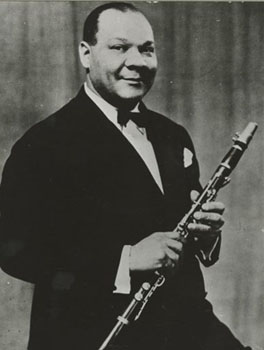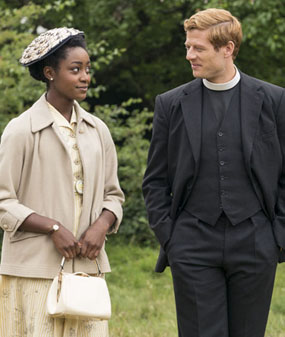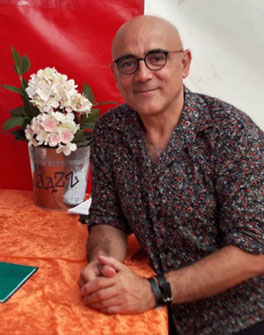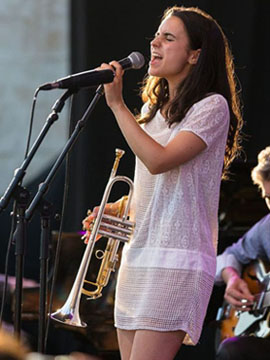I woke up with the tune “Petite Fleur” stuck in my head. Later I had a chance to look into it on the world wide web (particularly the musically remarkable side of YouTube).
All this finally led to Joan Chamorro at the Municipal School of Music of Sant Andreu in Barcelona, whose graduates include the brilliant 24-year-old Andrea Motis (sax, trumpet, voice), her younger sister Carla (guitar), and Èlia Bastida (sax, voice, and especially violin — “tributo al gran violinista Stéphane Grappelli”).
Petite Fleur and Sidney Bechet
The good enough Wikipedia entry on “Petite Fleur” is one beginning. The tune is “an instrumental written by Sidney Bechet and recorded by him in January 1952 … In 1959 it was an international hit as a clarinet solo by Monty Sunshine with Chris Barber’s Jazz Band … peaked at No. 5 on the US Hot 100 and No. 4 in the UK charts.”
I remember the Monty Sunshine recording. (I am that old.) Somewhat later, I learned a little about Sidney Bechet. He began as a clarinet player but added a “straight” soprano saxophone to his act in his early 20s. He grew up in a musical family in early 20th century New Orleans, where he learned to play several other instruments more casually.
According to Scott Yanow at allmusic.com : “Sidney Bechet was the first important jazz soloist on records in history (beating Louis Armstrong by a few months).” In his mature incarnation he played the soprano saxophone with “a wide vibrato that listeners either loved or hated.” I find his sound suitably distinctive and intriguing, without exactly wanting jazz today to emulate it.
Bechet was also a “Creole of color” in New Orleans, with a surname and probably more that stretched back to the 18th century French American empire in old Louisiana. I had been dimly aware that his musical career had connections with modern France as well. But I knew no details until my current pursuit of “Petite Fleur.”
After early beginnings as a teenage clarinetist in New Orleans, Sidney Bechet first went to Europe with Will Marion Cook’s Syncopated Orchestra (out of New York City) in 1919. He returned to the United States where he began his recording career in 1923.

Then he was back in Europe in 1925 — with “other members of the Revue Nègre, including Josephine Baker.” (See what strikes me as the very good short Wikipedia biography.) In 1928 he led a “small band at Chez Bricktop in Montmartre, Paris.”
He was back in the USA by the early 1930s, where he performed and recorded over the next two decades. But by the late 1940s the postwar bebop revolution had begun to transform the American universe. The older Bechet found it harder to get work.
As explained by Wikipedia : “He believed that the jazz scene in the United States had little left to offer him … In 1950 he moved to France, after his performance as a soloist at the Paris Jazz Fair caused a surge in his popularity in that country, where he easily found well-paid work.”
It was in his new home in France that Sidney Bechet wrote “Petite Fleur,” which he first recorded in January 1952.
The last years of his career in his new country (and at least one of his old-world homelands) were a great success, musically and financially. Like too many practitioners of his craft, he nonetheless died too early “in Garches, near Paris, of lung cancer on May 14, 1959, his 62nd birthday.”
Sidney Bechet and Sidney Chambers : a footnote
As one sign of the broadly “European” if not exactly “American” popularity Bechet enjoyed in his late career (with something of a holdover even today), the Anglican clerical hero of the 2014–2018 “British ITV detective drama” Grantchester — set in the English countryside of the 1950s — recurrently plays Sidney Bechet records, to the dismay of some around him.
(And note that “Sidney Chambers,” the hero in question, finally leaves the series by marrying a visiting African American lady, and moving to the USA!)
Joan Chamorro, Andrea Motis, and the Sant Andreu Jazz Band in Barcelona today : An introduction
Sixty years after Sidney Bechet’s death in 1959, my world-wide-web pursuit of “Petite Fleur” soon enough led to a 2011 performance of his 1952 classic by a 16-year-old girl from Barcelona — in Catalonia, which may or may not also want to be in Spain. See “Petite Fleur — Andrea Motis, Joan Chamorro & Josep Traver” (on YouTube, like all the other music here).
From this point on my story can be pursued in several directions. And this installment could just be the first of at least two takes on the larger subject. It focuses on the remarkable career of Ms Andrea Motis, who is now 24 years old, and still apparently living in Barcelona (through all the recent political struggles there and in Spain at large).
Two quick background notes up front : First, before leaving Sidney Bechet’s “Petite Fleur” altogether, another remarkable more recent YouTube performance of the tune (much different from the 1959 Monty Sunshine clarinet hit), is a 2001 tenor sax recording by the free jazz pioneer Archie Shepp (who was born in Florida in 1937 and grew up in Philadelphia).
Second, Joan Chamorro is a teacher in his late 50s whose work at Barcelona’s Municipal School of Music of Sant Andreu has developed and promoted such awesome young musicians as Andrea Motis. He has been called a “musician, music educator and band leader, creator and leader of the successful youth band Sant Andreu Jazz Band … coordinator of a network of musicians and … other people who … work … with SAJB … jazz musician who plays bass, baritone, tenor, alto and soprano saxophone, clarinet, bass clarinet, flute, cornet and double bass.”
Andrea Motis so far seems the most widely known and accomplished younger musician to have evolved through Joan Chamorro’s Sant Andreu Jazz Band and related networks. There are now such things as the Andrea Motis & Joan Chamorro Quintet (in which Mr. Chamorro plays string bass) and the Motis Chamorro Big Band (where he also performs on baritone saxophone).
On YouTube the musical growth of Andrea Motis can be traced from a charmingly innocent 16-year-old who performs an enchanting version of Sidney Bechet’s “Petite Fleur” on a “curved” soprano saxophone, in Barcelona in 2011, to a more worldly 24-year-old who sings and plays trumpet on the almost mournful “Dança da solidão” (in English “Dance of Loneliness,” by the Brazilian singer–songwriter Paulinho da Viola) in Zurich, Switzerland in 2019.
As Wikipedia explains, along with her saxophone and trumpet playing, Ms Motis “sings in Catalan, Spanish, Portuguese and English.” (The lyric to “Dança da solidão is in Portuguese.) I am most interested in her saxophone playing. But I’m intrigued that her combination of saxophone and trumpet has a precedent, in the happily long-lived career of the American jazz great Benny Carter — born in Harlem, New York City 1907 and died in Los Angeles 2003.
(Also intriguingly enough, in 2010 the then 79-year-old American alto saxophone disciple of the still unsurpassed Charlie Parker, Phil Woods, was in Catalonia to perform an arrangement of his Benny Carter tribute tune, “My Man Benny” with the Barcelona Jazz Orchestra. On baritone sax in the Orchestra was Andrea Motis’s early teacher and later bass player, Joan Chamorro.)
Andrea Motis’s saxophone playing (soprano and alto) shows its power early on with her 16-year-old “Petite Fleur” in 2011. She has listened hard to the Sidney Bechet recordings, and offers an updated reading of his sound with the side that some listeners hated turned off. She takes the old New Orleans Bechet (1910–1940 say) in somewhat new directions, without going as far into “modern jazz” (1940–1970) as Archie Shepp on his striking 2001 “Petite Fleur” recording.
Ms. Motis’s exact style of saxophone playing can vary as well with the history of the tunes she takes up. More than one YouTube comment writer on her entrancing alto sax performance of the Duke Ellington (and Carl Sigman) tune,“All Too Soon,” has noted similarities with the longtime alto sax master of the Ellington band, Johnny Hodges.
(And there is a beautiful Johnny Hodges recording of “All Too Soon” that Andrea Motis has almost certainly listened to. A purist might nonetheless want to point out that in the original Ellington band version of 1940 the melody is played by a muted trombone, and the only saxophone solo is by Ben Webster on tenor.)
There are at least two Andrea Motis performances of “All Too Soon” on YouTube, and on one of them she plays with the contemporary American alto sax master Jesse Davis (born in New Orleans in 1965). It is no accident that Ms Motis — along with Joan Chamorro and the Barcelona guitarist Josep Traver — has also played with Scott Hamilton (born in Providence, Rhode Island in 1954) : a “swinging tenor saxophonist” who “first emerged in the ’70s playing a style that hearkened back to the pre-bebop sound of artists like Ben Webster.”
Barcelona Blues Today : A too hasty initial assessment
Along with the New Orleans that invented Sidney Bechet, one side of the Motis-Chamorro-Sant Andreu Jazz Band inspiration in the early 21st century is the American “mainstream” or “swing jazz” era of the 1930s and 1940s.
Another is the French small-group jazz of the same era perfected by the guitarist Django Reinhardt and the violinist Stéphane Grappelli.
Yet another is the Afro-Brazilian music first identified with Antonio Carlos Jobim and bossa nova in the 1960s.
Still another is the American jazz of the 1950s, 1960s, and 1970s “that drew inspiration from gospel music and blues.”
Or at least that’s how an initial enthusiastic burst of YouTube listening has struck me, more or less. And (driven by an escalating sense that this first installment of “Barcelona Blues Today” must end soon), here are half a dozen tunes on YouTube that broadly illustrate my almost certainly too hasty initial assessment :
- Andrea Motis, Joan Chamorro, Scott Hamilton and others on Jobim’s “Meditaçao” (or in English “Meditation”).
- Motis-Chamorro Quintet with Scott Hamilton offers “a spirited version of the Astaire-Berlin classic ‘Cheek To Cheek’” (at the Jamboree Club in Barcelona).
- The Sant Andreu Jazz Band plays “Minor Swing” — a “gypsy jazz tune” by Django Reinhardt and Stéphane Grappelli, first recorded in 1937.
- Andrea Motis, Joan Chamorro, and guitarist Josep Traver perform the American Songbook standard “Tenderly” at the Festival Django Reinhardt in Samois-sur-Seine, France.
- The Andrea Motis Joan Chamorro Big Band (with Ms Motis singing and Mr Chamorro on baritone sax) energetically races through the American Songbook standard “Just Friends”.
- Andrea Motis and friends play “Moanin,” the Art Blakey Jazz Messengers’ gospel-blues hit of 1959, by Bobby Timmons, at the Heineken Jazzaldia in San Sebastian, Spain.

The best place to end this introduction to Andrea Motis, Joan Chamorro, and their many other friends is a more-than-an-hour-long YouTube video from just this past late September 2019.
It presents Andrea (singing and on trumpet), Joan (Chamorro, on bass), the guitarist Josep Traver, Andrea’s younger sister Carla also on guitar, Anastasia Ivanova (trombone and scat singing), an excellent young male tenor sax player, Joan Marti, and various other young musicians (including Elia Bastida as a vocalist), wandering in and out of the space in front of a bar on an early fall afternoon in the Sant Andreu neighbourhood of Barcelona.
They are playing at “el festival de jazz de sant Andreu, como cada año, el bar Colombia.” They are having serious fun, returning to a jazz that is improvisational with much joyful spontaneity, but also played within a less complex theoretical framework that is almost certainly more listenable for a broader audience, than much of what the modern jazz of 1940–1970 has left us.

Even for those of us who think Charlie Parker is still the absolute top and bebop still the hardest and best jazz to play — and listen to.
With Europe and America at the 70th NATO summit clouding my mind, I find it o-so-warmly reassuring to see how some of the seriously great things the USA has given the universe are being cultivated in 2019 in Catalonia. (Especially reassuring after George Orwell’s grim Homage to Catalonia in 1938.)
Today Catalonia may or may not really want to be a part of Spain. Not altogether unlike Quebec in Canada, Canadians are bound to think. As the early snow rises around us in this year of climate change, crazy politics, and the 2-faced nice guy Justin Trudeau, still much admired on the street where I live …
Toronto, Canada. December 5, 2019.
Tags: Andrea Motis, Archie Shepp, Carla Motis, Èlia Bastida, Homage to Catalonia, jazz in Barcelona, Joan Chamorro, Josep Traver, Petite Fleur, Sant Andreu Jazz Band, Scott Hamilton, Sidney Bechet










Recent Comments